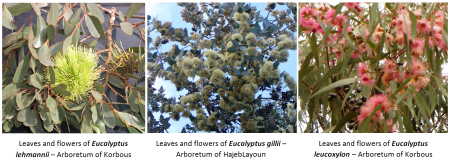
Objective:
The current exploitation of rosemary and myrtle (native species with relatively high yield of EO) occupies an important place in the forestry sector and a significant socio-economic interest. Eucalyptus trees can play a predominant and substantial role thanks to their richness in essential oils, their composition and their commercial value.
This objective necessarily involves the identification of eucalyptus EO species and the selection of the most efficient in terms of the yield of essential oils and the presence of the most dominant active compounds which are preferentially sought by the industrialists.
Context:
Eucalyptus species are generally high in EO. Actually the EO yield is closely related to the species. However even among the same species, it widely varies. It depends on several factors including intrinsic factors, specific to the species and extrinsic factors related to the environment. A large number of eucalyptus species, still until now unknown, could be valued and used for example to produce EO. These species are formally introduced by forest research; nevertheless, they are only present, in the arboretums, for experimental purpose.
The present study aims at quantifying and chemical characterising EO obtained from 58 Eucalyptus species of 7 arboretums in the north and center of the country.
Contacts:
Ameur Elaissi, ameur.elaissi@gmail.com, http://www.inrgref.agrinet.tn/fr/
Mariem Khouja,khouja.mariem@gmail.com, http://www.inrgref.agrinet.tn/fr/
Mohamed Larbi Khouja, khouja.larbi15@gmail.com, http://www.inrgref.agrinet.tn/fr/
Further information:
A. Elaissi, I. Chraief, F. Bannour, F. Farhat, M. Ben Salah, R. Chemli, M. L. Khouja, ‘Contribution to the qualitative and quantitative study of seven Eucalyptus species essential oil harvested of Hajeb’sLayoun Arboreta (Tunisia)’, J. Essent. Oil-Bear.Plants 2007, 10, 15.
A. Elaissi, H. Medini, H. Marzouki, M. L. Khouja, F. Lynene, R. Chemli, F. Harzallah-Skhiri, ‘Variation in volatile leaf oils of twelve Eucalyptus species harvested from HajebLayoun Arboreta (Tunisia)’, Chem. Biodiversity 2010, 7, 705–716.
A. Elaissi, H. Marzouki, H. Medini, M. L. Khouja, F. Farhat, F. Lynene, F. Harzallah-Skhiri, R. Chemli, ‘Variation in volatile leaf oils of 13 Eucalyptus species harvested from Souinet Arboreta (Tunisia)’, Chem. Biodiversity 2010, 7, 909–921.
A. Elaissi, H. Medini, M. L. Khouja, M. Simmonds, F. Lynene, F. Farhat, R. Chemli, F. Harzallah-Skhiri, ‘Variation in volatile leaf oils of eleven Eucalyptus species harvested from Korbous Arboreta (Tunisia)’, Chem. Biodiversity 2010, 7, 1841–1854.
A. Elaissi, H. Medini, M. L. Khouja, M. Simmonds, F. Lynene, F. Farhat, R. Chemli, F. Harzallah-Skhiri, ‘Variation in volatile leaf oils of five Eucalyptus species harvested from JbelAbderrahman Arboreta (Tunisia)’, Chem. Biodiversity 2011, 8, 352–361.
A. Elaissi, H. Medini, M. L. Khouja, M. Simmonds, F. Lynene, F. Farhat, R. Chemli, F. HarzallahSkhiri, ‘Variation in volatile leaf oils of seven Eucalyptus species harvested from Zerniza Arboreta (Tunisia)’, Chem. Biodiversity 2011, 8, 362–372.
A. Elaissi, K. Hadj Salah, S. Mabrouk, M. L. Khouja, R. Chemli, F. Harzallah-Skhiri, ‘Antibacterial activity and chemical composition of 20 Eucalyptus species essential oils’, Food Chem. 2011, 129, 1427–1434.
A. Elaissi, Z. Rouis, S. Mabrouk, K. Bel Haj Salah, M. Aouni, M. L. Khouja, F. Farhat, R. Chemli, F. Harzallah-Skhiri, ‘Correlation between chemical composition and antibacterial activity of essential oils from fifteen Eucalyptus species growing in the Korbous and JbelAbderrahman Arboreta (North East Tunisia)’, Molecules 2012, 17, 3044–3055.
A. Elaissi, Z. Rouis, N. Abid Ben Salem, S. Mabrouk, Y. Ben Salem, K. Bel Haj Salah, M. Aouni, F. Farhat, R. Chemli, F. Harzallah-Skhiri, M. L. Khouja, ‘Chemical composition of 8 Eucalyptus species’ essential oils and the evaluation of their antibacterial, antifungal and antiviral activities’, BMC Complementary Altern. Med. 2012, 12, 81.
Ameur Elaissi, Sarra Moumni, Kevin Roeleveld, and Mohamed Larbi Khouja, 2020.Chemical Characterization of Five Tunisian Eucalyptus Essential OilsSpecies.Chem. Biodiversity, 17, e1900378.
M. L. Khouja, A. Khaldi, M. N. Rejeb, ‘Results of the Eucalyptus introduction trials in Tunisia’, Proceedings ofthe International Conference Eucalyptus in the Mediterranean basin: perspectives and new utilization, October 15–19, 2000, Centro Promozione Publicità, Florence, 2001.